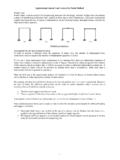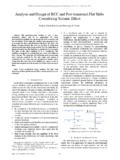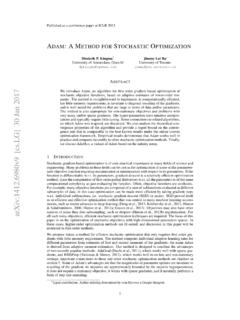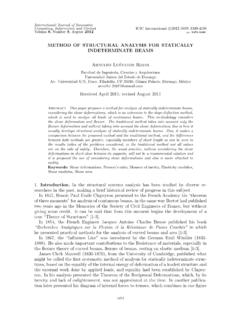Transcription of AD 2 534 - Defense Technical Information Center
1 UNCLASSIFIEDAD 287 534/a4 GdAcedARMED SERVICES Technical Information AGENCYARLINGTON HALL STATIONARLINGTON 12, VIRGINIAUNCLASSIFIEDNOTICE: When government or other drawings, speci-fications or other data are used for any purposeother than in connection with a definitely relatedgovernment procurement operation, the U. thereby incurs no responsibility, nor anyobligation whatsoever; and the fact that the Govern-ment may have formulated, furnished, or in any waysupplied the said drawings, specifications, or otherdata is not to be regarded by implication or other-wise as in any manner lic nsing the holder or anyother person or corporation, or conveying any rightsor permission to maufacture, use or sell anypatented invention that may in any way be REPORT R-1653, A TRIFILAR PENDULUMIf FORTHE DETERMINATION OF MOMENTS OF INERTIABYA. L. KORRandCC PAUL HYERRTAUGUST 196 ZFRANKFORD ARSENALRESEARCH AND DEVELOPMENT GROUPPITMAN -DUNN LABORATORIESPHILADELPHIA 37, requesters may outain copies of this report findings in ttis report are not to be construed as anofficial Department of the Army R-1653A TRIFILAR PENDULUMFORTHE DETERMINATION OF MOMENTS OF INERTIAPREPARED BY: aA.
2 L. KORRM echanical EngineerPAUL HAPhysicistREVIEWED BY:G. S. VANJRA cting ChiArtillery Ammo Components DivisionAPPROVED BY: (f ':C. C. FAWCETTA cting ChiefResearch and Development GroupPitman-Dunn LaboratoriesFOR:C. W. EIFLERC olonel, Ord CorpsCommanderResearch and Development Group, Pitman-Dunn LaboratoriesFrankford Arsenal, Philalelphia 37, authors wish to acknowledge the contributions of MissWinifred Green, Messrs. James Brady and Spencer Hirschman ofFrankford Arsenal, and Mr. R. Roberts of Lehigh University. Theseindividuals made it possible for the early completion of this unique trifilar pendulum was constructed at Frankford Arsenalwhich proved to be an accurate tool for the determination of momen':sof inertia of non-homogeneous pendulum was used with a calibration curve. The curve wasgenerated by plotting a quantity calculated from the weight and the periodsquared of a number of homogeneous solids of revolution of increasingsize as ordinates, against the calculated (using handbook formulae) mo-ments of inertia of these solids as moment of inertia of an unknown was obtained by weighing the ob -ject, establishing its period on the pendulum, locating a quantity calcu]atedfrom its period squared and its weight as an ordinate on the calibration curve,and finding the moment of inertia as the corresponding are specialized techniques used in operating the pendulumand some unique features in its design for which patents have been ap-plied.)
3 The need for such unique features is established, and erroranalysis shows this trifilar pendulum accurate to 0. 5%.It is concluded that the trif;1ar penLdulum, if properly constructed,has certain advantages over the torsion rod pendulum with no more LATUREi, j, k Rectangular coordinate system unit Vector from axis of rotation of Trifilar Pendulum to onewire of trifilar pendulum and perpendicular to axis Magnitude of Length of suspending Period of oscillation of Trifilar (alpha) Rotational displacement of weight suspended on (eta) Reference argle orienting R with respect tL. rectangularcoordinate sy,te (beta) Complement of 7) ; also, angle between incident andreflected light beams at moving mirror on (theta) Angle between pendulum wire and vertical under (gamma) Time constant of attenuation of motion of trifilar (phi) Phase angle associated with periodic motion of trifilarpendulum.
4 't (tau) Torque; also, probable (omega) Frequency of oscillation of trifilar pendulum; bydefinition,Tiv'TABLE OF CONTENTSS ection Title Page No,ABSTRACT..iiiNOMENCLATURE .. ivINTRODUCTION .. 1 DISCUSSION .. 1 THEORY .. 2 METHOD .. 3 CONSTRUCTION AND METHOD OF OPERATION .. 4 ERROR ANALYSIS .. 9 CONCLUSIONS ..18 FUTURE WORK .. 18 APPENDIX I .. 19 APPENDIX II .. zSAPPENDIX III .. 25 APPENDIX IV .. 29 APPENDIX V .. 34 DISTRIBUTION .. 50 VINTRODUCTIONIn July of 1957, a project was undertaken to build a pendulumcapable of determining the moment of inertia of a device of approxi-mately 4 lbs in weight, having an odd configuration. Si,-c,-. a timelimitation was given to produce the pendulum at the lowest possiblecost, it was decided to build a trifilar pendulum, from scrap materialavailable at Frankford resulting pendulum has a configuration of structural elements,consisting of tubing, angles and plates of a size available at the time ofconstruction.
5 The mirrors used were manufactured from laboratorycoverglasses which were silvered by our optical shop. The photocelland amplifier were part of surplus equipment. The only purchasedparts were timers and a the pendulum had been built and had proven its worth by ther, lative accuracy of its results, a patent application was filed based ona number of its unique dynamics the moment of inertia of a body is to rotary motionas its mass is to linear motion. Engineers, therefore, should, in anyinvestigation, concern themselves with the values used for momentsof inertia as they do for values of general, an investigator may calculate the value of a momentof inertia or find it by experiment. For irregular or nonhomogeneoussolids, calculation is usually impractical. This report describes adevice for determining moments of inertia of solids unamerable tocalculation, and the method of its operation. The device is called atrifilar simple pendulum consists of an oscillating weight hung froma single wire.
6 The weight, or bob, is free to swing in a plane (or inan elliptical path, which is just two plane paths superimposed) orrotate about an axis at a constant rate,I |maw |wmw m m mmmlmmm m m torsion rod pendulum (used in empirical methods of findingmoments of inertia) also has a single wire, but the wire is thickenough to exert a measurable restoring torque on the bob when thewire is twisted. It should be remembered that moments of inertia(unless calculated) may only be found experimentally by imparting anangular acceleration to the object under investigation. Physically,there cannot be a scale or balance or any static test for finding mo-ments of th,. t"ifilar (three-wire) pendulum, the wire size used is asthin as the el-stic limit will allow. Thin wires, of the size used, havea torsional small enough to ignore. The wires are hung sothat when tl'e bob has been rotated and set free, a restoring torquetwists it baclk toward the equilibrium position, and pcriodic motionsets in (fir.)
7 !+ The weight and moment of inertia of the bob and somedimensions of &+e pendulum fix the Appendix I contains the derivation of the formula for momentof inertia from the equation of motion of the trifilar pendulum:*WR2Ti'1=41 YZLG. W. Hughes, Sandia Corp., The Trifilar Pendulum and Its Applica-tion to the Experimental Determination of Moments of inertia (ASME57-SA-51, 1957) p. ~l k~~li liltmlml i li d~W l N i m imll ll~~lWli idN~ m m rllJ~ m lilHil? ..i2 IWhereI = moment of inertia of the bob (test object plus hardware)W = weight of the bobR = perpendicular distance from the axis of the bob (about whichit rotates) to the Center line of any one of the wires (fig. 1)T = period for one full cycleL = length of wire from the supporting frame to the technique used in determination of moments of inertia of un-known nonhomogeneous solids by use of the trifilar pendulum involves theuse of a calibration curve.
8 This curve is obtained by (1) calculating thevalues of the moments of inertia of standards; (2) weighing each standard(Ws); (3) weighing the holding fixture (Wo); mounting each standard onthe holding fixture; (5) imparting an oscillation to the assembly; (6) de-termining the period (Ts+o); (7) imparting an oscillation to the holdingfixture without a standard; (8 determining its period (TO); (9) calculatingthe quantity (W. -;. Wo) (Ts+o) -WoTo; and, (10) plotting this value asordinate against the corresponding calculated moment of inertia moment of inertia of an unknown is found by (1) weighing it(Wx); (a) mounting it on the holding fixture; (3) imparting an oscillationto the assembly; (4) determining the period (Tx+o); (5) calculating thequantity (Wx + Wo) (Tx+o)2 -WoT2 ; (5) finding the point on the calibrationcurve whose ordinate is this quantity; and (6) reading the abscissa of thispoint as the desired moment of inertia.)
9 This value is the moment ofinertia of the the unjKnown could be oscillated without using the holding fixture,one would obtain the period of oscillation of just the unknown (Tx). Aholding fixture is necessary, however, and, in general, Tx J Tx+ WxTZ, which is the factor in the formula for the moment of inertiaof just the unknown (see App. I), must be found indirectly. Let 1o standfor the moment of inertia of just the holding fixture, Ix that of the un-known, and Ix+o that of the combination. Adding moments of inertia3Ix+o = Ix+ 10 Using the trifilar pendulum formula (see App. I) and cancellingconstants,(Wx 4 Wo) (Tx+o)z = WxTxz + WoTo2soWxTx -(Wx + Wo) (T+0) -W0 TozThe amount on the right is the WT2 used as ordinate of the ca~ibra-tiom curve. Ix is the abscissa, so the unknown moment of inertia canbe read directly from the standards used to provide points for the calibration curvewere homogeneous cylinders of steel or aluminum, accurately weighedand measured.
10 Theoretically true moments of inertia (axial and trans-verse) were calculated using handbook standards are divided into two families; one set had a con-stant height with increasing radius while the other had constant radiusand increasing of these standards had its period timed for both axial andtransverse axes. Each standard, then, gave two points for the calibra-tion curve. There were six standards in each of the two families, soa total of twenty-four points was collected. The weight and period ofthe hardware alone gives another point which is, of course, the originof the AND METHOD OF OPERATIONT hree pieces of aluminum tube rise from the floor and connectat the top and middle to crosswise pieces of angle iron, forming theframe. A triangular yoke of flat pieces of steel welded together is4bolted to the midpoints of the top angle irons (figs. Z & 3). It wasoriginally planned to have the uprights join right to the yoke (fig.)

















